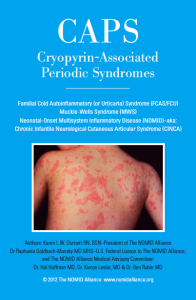Below are links to helpful research and information relating to Hyper-IgD syndrome (HIDS). These are not all the studies available. For more search at Pubmed.gov. You can also read more about HIDS here.
The Phenotype and Genotype of Mevalonate Kinase Deficiency – Published in 2016, this is one of the largest studies of HIDS and MA patients.
Some findings from this study:
- Flare triggers included vaccination, stress, and infections.
- Many patients had symptoms between flares.
- Almost all patients had GI involvement. Most experienced abdominal pain, diarrhea, and vomiting. Some had these symptoms when not in a fever episode. 18 patients had severe GI symptoms including aseptic peritonitis, GI bleeding, perianal ulcers, intestinal occlusion, gut perforation, and GI ulcers.
- One patient had macrophage activation syndrome (MAS) that started as a typical flare. This patient was only being treated with NSAIDS at the time of the flare that turned into MAS.
- Of 15 patients who tried statins for treatment, it failed in 11 and made the disease worse in 3.
- Colchicine was not effective in most.
- NSAIDS had some benefit for most, but was not highly effective.
- Corticosteroids were highly effective in most for terminating flares.
- Interleukin-1 biologics (anakinra and canakinumab) were effective in most, but not as effective as what is seen in CAPS patients.
- Some patients did not benefit from any biologic medications, but in some cases that may have been due to insufficient dose.
- 27 patients tried etanercept. 2 had a complete response. 14 had some response. In 11 patients etanercept failed as a treatment.
Hyper-IgD syndrome/mevalonate kinase deficiency: what is new? – Published in 2015, this is an updated overview of HIDS and MA (mevalonate aciduria). The biological pathway is discussed. Current best treatments are Il-1 inhibitors (anakinra and canakinumab), although not all patients have a complete response to these treatments.
Rheumatology: Hyperimmunoglobulinemia D with Periodic F ever Syndrome – Chapter on HIDS in the medical book Rheumatology.
Mevalonate Kinase Deficiency (MKD) (or Hyper-IgD Syndrome) – This is from the Paediatric Rhematology International Trials Organisation (PRINTO). It’s a good simple explanation for HIDS – great for passing out to family, friends, teachers to help explain this condition.
NORD: Mevalonate Kinase Deficiency – This has excellent easy to understand details on HIDS and MA symptoms, risks, and complications, and latest research, and treatment options.
A81: spectrum of mevalonate kinase deficiency: is colitis more common than we think? “The persistence of ESR elevation outside of febrile episodes seen in patients with HIDS/MKD may indicate the presence of chronic subclinical inflammation. Hematochezia was commonly seen, and could indicate the presence of colitis.”
Efficacy of interleukin-1-targeting drugs in mevalonate kinase deficiency – This study followed 11 HIDS patients who anakinra (Kineret) or canakinumab (Ilaris). Kineret was used on demand (with flares only) in one patient. Two patients used anakinra 3 times a week. Dosing of anakinra ranged from 1 to 5 mg/kg/day. Dosing of canakinumab ranged from 2 to 7 mg/kg every 4 to 8 weeks depending on the patient. “… our observations show that all patients with MKD had an improvement of disease activity under IL-1-targeting drugs with regard to the reduction of a clinical score during attacks, the reduction of the duration and frequency of attacks, and the decreased biological inflammation. However, complete clinical and biological remission was obtained in only one of nine patients on anakinra and three of six on canakinumab.”
Mevalonate kinase deficiency: current perspectives (July 2016) – Highlights from this study:
- “…there is some hint that MAS may be a relatively common complication of MKD.”
- MKD symptom presentation and severity is highly variable.
- Sometimes flares have a cyclic fever pattern of every 4 to 6 weeks (very similar to PFAPA pattern), sometimes flares are triggered.
- “(V377I) …high carrier rate would imply a much higher disease incidence than what is typically reported and suggests that many individuals who are homozygous for the V377I variant have a mild phenotype that is not recognized as MKD…HIDS and MA phenotypes are clearly defined entities, but MKD encompasses patients with overlapping features and even those with a minimal or clinically silent course.”
- Statins can trigger flares in some, particularly patients with MA. Statins as a treatment “has been largely abandoned.”
- “…the elevated risk for pneumococcal infections and progression to life-threatening sepsis has been documented in some larger cohorts. It has been speculated that increased plasma mevalonic acid is advantageous for the bacterium’s survival in blood and tissues.”
- Single mutation HIDS and the wide and variable range of disease severity and symptoms may be due to “the role of additional genes as modifiers…,” an area of current active research.
Inherited Metabolic Disease in Adults: A Clinical Guide – This medical textbook includes a chapter on mevalonate kinase deficiency (MKD). This textbook can be purchased here.
Different Presentations of mevalonate kinase deficiency: a case series – This gives details on 4 patients with HIDS and the symptoms they experienced.
Single MK mutation and recurrent fevers – This study compared symptoms and severity of patients with 2 mutations for HIDS with patients with 1 mutation for HIDS. “Aside for the presence of rash and high IgA and IgD levels in those children with 2 MVK mutations, there are no significant clinical differences between these groups.”
Treatment of hyperimmunoglobulinemia D syndrome with biologics in children: review of the literature and Finnish experience. – “The accumulating evidence on the efficacy and safety of biological drugs in pediatric HIDS suggests that the anti-interleukin-1 agent anakinra is the drug of choice for HIDS in children… Based on the 90 % response rate, anakinra seems to be the drug of choice for HIDS in children.”
Canakinumab treatment in patients with HIDS – “The median number of flares/patient reduced from 5(3-12) during the HP to 0(0-2)…”
Long-term follow-up in a national cohort of MKD patients: search for clinical predictors of a spontaneous improvement “The homozygous state for V377I and female sex are associated to a spontaneous improvement of disease course in MKD patients.”
Periodic Fever in MVK Deficiency: A Patient Initially Diagnosed with Incomplete Kawasaki Disease
Observational Study of a French and Belgian Multicenter Cohort of 23 Patients Diagnosed in Adulthood With Mevalonate Kinase Deficiency – “Twenty-three patients were analyzed. The mean age at diagnosis was 40 years, with a mean age at onset of symptoms of 3 years. All symptomatic patients had fever. Febrile attacks were mostly associated with arthralgia (90.9%); lymphadenopathy, abdominal pain, and skin lesions (86.4%); pharyngitis (63.6%); cough (59.1%); diarrhea, and hepatosplenomegaly (50.0%). Seven patients had psychiatric symptoms (31.8%). One patient developed recurrent seizures. Three patients experienced renal involvement (13.6%). Two patients had angiomyolipoma (9.1%). All but one tested patients had elevated serum immunoglobulin (Ig) D level. Twenty-one patients had genetic diagnosis; most of them were compound heterozygote (76.2%). p.Val377Ile was the most prevalent mutation. Structural articular damages and systemic AA amyloidosis were the 2 most serious complications. More than 65% of patients displayed decrease in severity and frequency of attacks with increasing age, but only 35% achieved remission.”
Tocilizumab in autoinflammation and AA amyloidosis – mentions use of tocilizumab (Actemra) in patients with amyloidosis, including one with HIDS.
Different clinical presentation of the hyperimmunoglobulin D syndrome (HIDS) (four cases from Turkey). Cases of “later-onset HIDS”.
A woman with recurrent “infections” since birth – a new mevalonate kinase mutation. A case of an adult misdiagnosed her entire life. She was diagnosed at age 32.
A Case of Hyperimmunoglobulinemia D Syndrome Successfully Treated with Canakinumab – “Treatment with canakinumab in a final single dose of 4 mg/kg every 4 weeks resulted in the disappearance of febrile attacks and a considerable improvement of patients’ quality of life during a 12-month follow-up period.”
Amyloidosis in a child with hyperimmunoglobulinemia d syndrome.
Hereditary autoinflammatory syndromes- with emphasis on hyper-IgD and periodic fever syndrome.
This one is long – 200 pages! It’s written by Dr. Simon, one of the lead HIDS researchers in The Netherlands and the world. It was written in 2008, so some information may be outdated. However, still lots of good info not easily found elsewhere. MWS, NOMID, FCAS, FMF and TRAPS are also discussed.
The Clinical Significance of a Single MVK Mutation in HIDS – Not all cases of HIDS have 2 mutations. This shows how those with only one MVK mutation can have the same symptoms as those with 2 mutations.
Mevalonate Kinase Deficiency: A Survey of 50 Patients– In depth survey study in France. Includes details on symptoms, prognosis, and treatments. “MKD is not only an autoinflammatory syndrome but also a multisystemic inflammatory disorder, a possible immunodeficiency disorder, and a condition that predisposes patients to the development of renal angiomyolipoma.” Renal angiomyolipoma is a benign kidney tumor.
Recurrent arthritis as a unique manifestation of hyperimmunoglobulinaemia D
Anakinra for the Treatment of Hyper-IgD with Periodic Fever Syndrome in Children
Autoinflammatory syndromes: diagnosis and management – a good synopsis of FMF, HIDS, TRAPS, CAPS, Blau Syndrome, PAPA Syndrome, PFAPA, and Majeed’s Syndrome. Gives information on differences in the diseases and best treatments as of 2010.
Long-Term Follow-Up, Clinical Features, and Quality of Life in a Series of 103 Patients With Hyperimmunoglobulinemia D Syndrome – Published in 2008, as of 2014, this was still the largest study of HIDS patients that followed patients into adulthood. Shows statistics for lifelong prognosis and treatments that worked in these patients.
Hereditary periodic fever with systemic amyloidosis: is hyper-IgD syndrome really a benign disease?
The autoinflammatory diseases – Published in 2012, this also covers FMF, MVK Deficiency (HIDS), TRAPS, CAPS, NLRP 12 mutations, Blau Syndrome, PAPA Syndrome, Majeed’s, DIRA, and PFAPA.
Retinitis pigmentosa in mevalonate kinase deficiency. – Eye damage that can occur with HIDS
Nummular keratopathy in a patient with Hyper-IgD Syndrome – Another eye condition associated with HIDS.
Hyperimmunoglobulinaemia D with periodic fever syndrome – A good synopsis of HIDS that’s easier to read and understand.
The Expanding Spectrum of Systemic Autoinflammatory Diseases: Misadventures in the Genomics of Inflammation – More information on the different fever disorders. From a lecture given by Dr. Kastner, has lots of details on individual cases.
Recurrent Pericarditis in a Child with Hyper IgD Syndrome Responding to Etanercept – Case of inflammation affecting the heart in HIDS.
Effect of etanercept and anakinra on inflammatory attacks in the hyper-IgD syndrome: introducing a vaccination provocation model – this study is in adults with HIDS.
Neonatal Hepatitis as First Manifestation of Hyperimmunoglobulinemia D Syndrome – Case of severe liver involvement in HIDS. “We present a case of severe HIDS in a young girl, whose symptoms started in the neonatal period with hepatomegaly, hepatitis, thrombocytopenia, and conjugated hyperbilirubinemia. From the age of five months, the child had recurrent febrile episodes, stomatitis, adenitis, and persistent hepatomegaly.”
MVK mutations and associated clinical features in Italian patients affected with autoinflammatory disorders and recurrent fever This includes symptom details for 15 patients with HIDS (MVK).
Diagnostic value of urinary mevalonic acid excretion in mevalonate kinase deficiency (MKD) – Study shows that some with HIDS mutations can have negative mevalonic acid excretion and some with no HIDS mutations found can have positive mevalonic acid urine tests.





